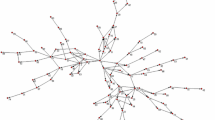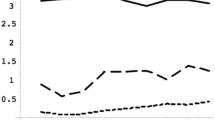Abstract
We study the influence of technological efficiency and organizational inertia on the emergence of competition when firms decide myopically. Using a multi-agent computer simulation model, we observe the competitive reaction of a former monopolist to the advent of a new competitor. While the entrant uses a new technology, the monopolist is free either to stick to his former technology or to switch to the new one. We find that—irrespective of details regarding the demand side—a change of industry leadership occurs only if the new (“disruptive”) technology is not too efficient and organizations are inert.
Similar content being viewed by others
References
Adner, R. (2003), “When are Technologies Disruptive? A Demand-Based View of the Emergence of Disruption,” Strategic Management Journal (forthcoming).
Axtell, R. (2000), “Why Agents? On the varied Motivations for Agent Computing in the Social Sciences,” Technical Report 17, Center on Social and Economic Dynamics, Washington, DC.
Christensen, C.M. (1993), “The Rigid Disk Drive Industry: History of Commercial and Technological Turbulence,” Business History Review, 67(4), 531–588.
Christensen, C.M. (1997), The Innovator's Dilemma. Harvard School Press, Boston, MA.
Christensen, C.M. and J.L. Bower (1996), “Customer Power, Strategic Investment, and the Failure of Leading Firms,” Strategic Management Journal, 17, 197–218.
Epstein, J.M. (2003), “Growing Adaptive Organizations: An Agent-Based Computational Approach,” Working Paper 03-05-029, Santa Fe Institute, USA.
Hauser, J. and D. Clausing (1988), “The House of Quality,” Harvard Business Review, 63–73.
Henderson, R.M. and K.B. Clark (1990), “Architectural Innovation: The Reconfiguration of Existing Product Technologies and the Failure of Established Firms,” Administrative Science Quarterly, 35(1), 9–30.
Klepper, S. and K.L. Simons (1997), Technological Extinctions of Industrial Firms: An Inquiry into their Nature and Causes. Oxford University Press.
Malerba, F., R. Nelson, L. Orsenigo and S. Winter (1999), “History-Friendly Models of Industry Evolution: The Computer Industry,” Industrial and Corporate Change, 8(1), 3–40.
Mas-Colell, A., M. Whinston and J.R. Green (1995), Microeconomic Theory. Oxford University Press, New York.
Nault, B.R. and M.B. Vandenbosch (2000), “Disruptive Technologies-Explaining Entry in Next-Generation Information Technology Markets,” Information Systems Research, 11(3), 304–319.
Rumelt, R.P. (1981), “Towards a Strategic Theory of the Firm,” in R. Boyden (Ed.), Competitive Strategic Advantage, Englewood Cliffs: Prentice Hall, pp. 556–570.
Tsvetovat, M. and K.M. Carley (2002), “Emergent Specializations in a Commodity Market: A Multi-Agent Model-Graduate Student Best Paper Award, CASOS 2001 Conference,” Computational and Mathematical Organization Theory, (8), 221.
Tushman, M.L. and P. Anderson (1986), “Technological Discontinuities and Organizational Environments,” Administrative Science Quarterly, 31, 439–465.
Author information
Authors and Affiliations
Rights and permissions
About this article
Cite this article
Buchta, C., Meyer, D., Pfister, A. et al. Technological Efficiency and Organizational Inertia: A Model of the Emergence of Disruption. Computational & Mathematical Organization Theory 9, 127–146 (2003). https://doi.org/10.1023/B:CMOT.0000022752.54325.37
Issue Date:
DOI: https://doi.org/10.1023/B:CMOT.0000022752.54325.37




